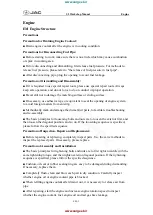
Making other settings
The other operating functions of Travel Assist corre-
spond to operation of ACC → page 162.
Troubleshooting
Please refer to
at the start of the chapter on
page 171.
Travel Assist is not available or does not func-
tion as expected.
The indicator lamp lights up yellow. A message will
also appear on the instrument cluster display.
— There is a fault in the sensor system. Check the
causes and remedies described in the information
on ACC → page 163 or Lane Assist → page 171.
— Fault or malfunction. Switch off and restart the
engine.
— The system limits have been exceeded.
— If the problem persists, go to a qualified work-
shop.
Take over steering.
The warning lamp lights up white and a message is
displayed in the instrument cluster display.
— You have released the steering wheel for a few
seconds. Take hold of the steering wheel and take
over vehicle control.
Take over steering.
The warning lamp lights up red and a message is
displayed in the instrument cluster display. An
acoustic warning is issued or the steering wheel vi-
brates, depending on the driving situation.
— You have let go of the steering wheel for an ex-
tended time or the system limits have been
reached. Take hold of the steering wheel immedi-
ately and take over vehicle control.
Travel Assist switches off automatically.
—
Vehicles without Emergency Assist:
You have re-
leased the steering wheel for an extended period
of time.
— Fault or malfunction. Switch off and restart the
engine.
— If the problem persists, go to a qualified work-
shop.
The control system is interrupted unexpectedly.
— You have activated the turn signal.
Semi-automatic vehicle con-
trol in a medical emergency
(Emergency Assist)
Emergency Assist can detect a lack of activity
on the part of the driver and keep the vehicle in
the lane automatically, or brake the vehicle to
a standstill if required. The system can there-
fore actively contribute to preventing or reduc-
ing the consequences of an accident.
Emergency Assist uses the same sensors as the
Adaptive Cruise Control (ACC) and the lane keeping
system (Lane Assist). Please read the information on
ACC → page 158 and Lane Assist → page 169 care-
fully and observe the listed system limits and in-
structions.
Driver intervention prompt
If there is no driver activity, Emergency Assist
prompts the driver to take control of the vehicle by
acoustic warnings and by a braking jolt. A message
will also appear on the instrument cluster display.
Depending on equipment, the driver's belt is also
tensioned simultaneously.
System intervention
If the driver does not respond, the system can brake
the vehicle and keep it in lane. Depending on the sit-
uation and the instrument cluster version, one of
following indicator lamps lights up:
System intervention (corrective
steering intervention).
The hazard warning lights will be switched on after
a short time to warn other road users if Emergency
Assist is actively intervening.
Depending on equipment, the system will hold the
driver in sitting position by tightening the belt.
The control of the system can be overridden at any
time by using the steering wheel or pedal.
If the remaining stopping distance is sufficient, the
vehicle will be braked to a standstill if necessary. The
electronic parking brake will then be switched on
automatically → page 178.
Switching on and off
Emergency Assist is always active when the ignition
is switched on if the following prerequisites are met.
— The lane keeping system (Lane Assist) and Adap-
tive Cruise Control (ACC) are switched on.
— A position has been selected for driving forward.
or
Semi-automatic vehicle control in a medical emergency
173
3G0012720AK




































